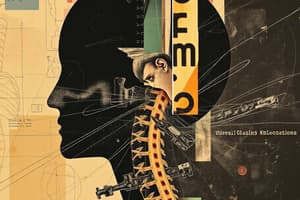Podcast
Questions and Answers
The Lateral Lemniscus is part of which pathway?
The Lateral Lemniscus is part of which pathway?
- Visual
- Sensory
- Auditory (correct)
- Motor
Damage to the Lateral Lemniscus results in what type of hearing loss?
Damage to the Lateral Lemniscus results in what type of hearing loss?
Contralateral
Damage to the Spinal Lemniscus results in which of the following?
Damage to the Spinal Lemniscus results in which of the following?
- Loss of conscious proprioception
- Loss of pain and temperature from the face
- Hearing Loss
- Loss of pain and temperature from the body (correct)
Damage to the Trigeminal Lemniscus results in which of the following?
Damage to the Trigeminal Lemniscus results in which of the following?
Which of the following is associated with Benedict's Syndrome?
Which of the following is associated with Benedict's Syndrome?
Which of the following is associated with Weber's Syndrome?
Which of the following is associated with Weber's Syndrome?
Which cranial nerve is affected in Millard Gubler's Syndrome, leading to medial squint?
Which cranial nerve is affected in Millard Gubler's Syndrome, leading to medial squint?
Which cranial nerve is affected in Ponto Cerebellar Angle Syndrome, leading to facial paralysis?
Which cranial nerve is affected in Ponto Cerebellar Angle Syndrome, leading to facial paralysis?
Which cranial nerve is affected in Ponto Cerebellar Angle Syndrome, leading to progressive deafness?
Which cranial nerve is affected in Ponto Cerebellar Angle Syndrome, leading to progressive deafness?
Flashcards
Lateral Lemniscus
Lateral Lemniscus
Auditory pathway responsible for C/L hearing loss.
Spinal Lemniscus
Spinal Lemniscus
Pathway that leads to C/L loss of pain and temperature from the body.
Trigeminal Lemniscus
Trigeminal Lemniscus
Pathway causing C/L loss of pain and temperature from the face.
Medial Lemniscus
Medial Lemniscus
Signup and view all the flashcards
Benedict's Syndrome
Benedict's Syndrome
Signup and view all the flashcards
Weber's Syndrome
Weber's Syndrome
Signup and view all the flashcards
Millard Gubler's Syndrome
Millard Gubler's Syndrome
Signup and view all the flashcards
Ponto Cerebellar Angle Syndrome
Ponto Cerebellar Angle Syndrome
Signup and view all the flashcards
C/L Hearing Loss
C/L Hearing Loss
Signup and view all the flashcards
C/L Loss of Pain
C/L Loss of Pain
Signup and view all the flashcards
C/L Loss of Temperature
C/L Loss of Temperature
Signup and view all the flashcards
Conscious Proprioception
Conscious Proprioception
Signup and view all the flashcards
Ptosis
Ptosis
Signup and view all the flashcards
Divergent Squint
Divergent Squint
Signup and view all the flashcards
Light Reflex Loss
Light Reflex Loss
Signup and view all the flashcards
Accommodation Reflex Loss
Accommodation Reflex Loss
Signup and view all the flashcards
C/L Hemiplegia
C/L Hemiplegia
Signup and view all the flashcards
I/L Facial Paralysis
I/L Facial Paralysis
Signup and view all the flashcards
I/L Ataxia
I/L Ataxia
Signup and view all the flashcards
Study Notes
Lateral Lemniscus Pathway
- Damage to the lateral lemniscus results in contralateral hearing loss.
Spinal Lemniscus
- Damage to the spinal lemniscus results in contralateral loss of pain and temperature sensation from the body.
Trigeminal Lemniscus
- Damage to the trigeminal lemniscus results in contralateral loss of pain and temperature sensation from the face.
Medial Lemniscus
- Damage to the medial lemniscus results in contralateral loss of conscious proprioception, touch, vibration, and stereognosis.
Benedict's Syndrome
- Contralateral loss of conscious proprioception, touch, vibration, and stereognosis.
- Contralateral loss of pain and temperature sensation from the body.
- Contralateral loss of pain and temperature sensation from the face.
- The third cranial nerve is affected resulting in ptosis, a divergent squint, and loss of light and accommodation reflex.
Weber's Syndrome
- Ipsilateral third cranial nerve palsy (ptosis, divergent squint, loss of light and accommodation reflex).
- Contralateral hemiplegia (paralysis of one side of the body).
- The upper motor neuron (UMN) of the eighth cranial nerve is affected leading to paralysis of the lower face.
Millard-Gubler Syndrome
- Sixth cranial nerve palsy (medial squint).
- Eighth cranial nerve palsy (facial paralysis).
- Contralateral pyramidal tract involvement (hemiplegia).
- Abducent (6th) nerve and pyramidal tract are involved.
Pontocerebellar Angle Syndrome
- Seventh cranial nerve involvement (facial paralysis).
- Eighth cranial nerve involvement (progressive deafness).
- Cerebellar involvement (ataxia).
- Vestibular nuclei involvement (occipital headache due to ICP).
Studying That Suits You
Use AI to generate personalized quizzes and flashcards to suit your learning preferences.




